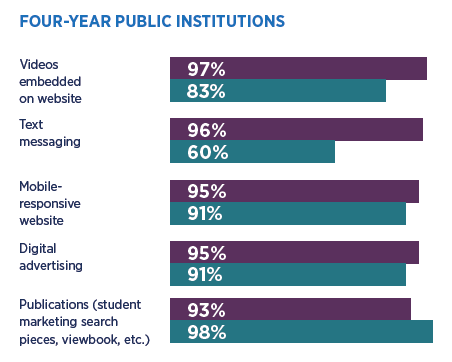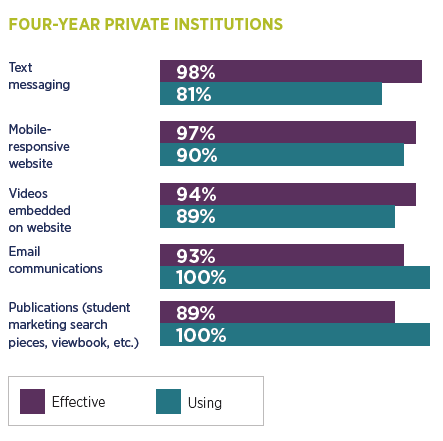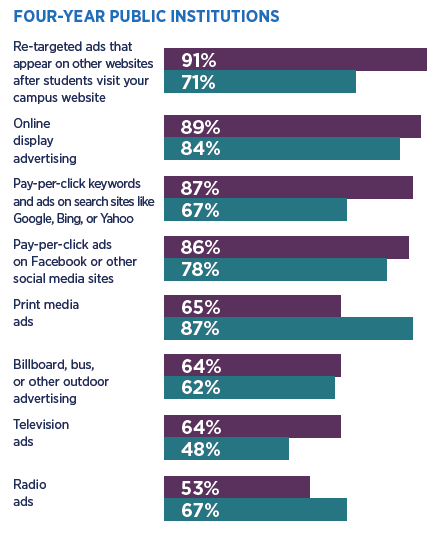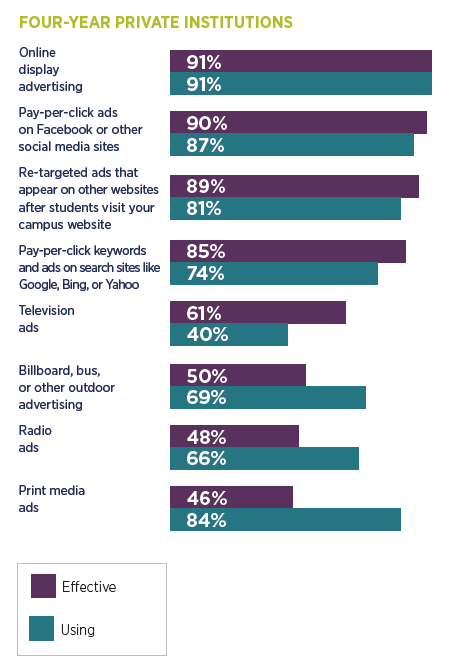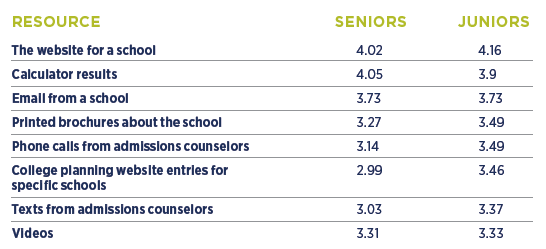enrollment
College Student Recruitment Practices: 5 Ways Institutions Need to Stop Doing the Same Old Thing
What’s working in college student recruitment and marketing? How are colleges and universities trying to engage prospective students, and are those practices aligned with how students are searching for schools? And how can campuses stop doing the “same old thing” and better align their strategies with what students expect?
Ruffalo Noel Levitz polled public and private institutions on their college student recruitment practices, and have published the findings in the 2018 Marketing and Student Recruitment Report of Effective Practices. This report looks at what institutions are doing to recruit students, and also how they assess the effectiveness of their practices. By comparing these findings to the 2018 E-Expectations Trend Report, which looks at student expectations and behavior during the college search process, you can see the opportunities campuses have to engage students more effectively across all channels (see our previous blog on E-Expectations).
Here are 5 key findings from the Marketing and Student Recruitment Report.
1) Colleges and universities are missing a big opportunity with text messaging
Nearly all institutions say text messaging is effective. But 4 out of 10 public institutions and 1 out of 5 private institutions are not using it with students.
Top 5 most effective outreach strategies for college student recruitment and marketing
Contrast this with what students said in the E-Expectations report:
- More than 80 percent of juniors and seniors say they have a smartphone
- 75 percent would provide cell phone numbers when completing a request for information form, and three-quarters said they would be open to some text messages from institutions.
Use text messaging with your prospective students. Give them a chance to opt in and then use texting to communicate key reminders and other information—key deadlines, invitations to visit campus, and other information that will push them to engage more with your institution.
2) Institutions need to look at ROI across all channels
Both public and private institutions continued to use expensive forms of traditional media such as outdoor advertising, radio, and print media even though they did not rate those forms of advertising as effective as digital advertising.
Advertising strategies: Effectiveness and usage
Compare these results to how students rated the resources they use in the E-Expectations report
Top resources for researching a campus (scale of 1-5, 5=most valuable)
Institutions do need to take a multichannel approach to college student recruitment, as students use a variety of resources to conduct their college research. However, in a multichannel era where campuses have a limited budget, they need to closely look at their ROI for mediums such as radio, billboards, television, and print ads when there are more affordable and trackable advertising methods available.
3) Engagement scoring with web tracking needs to grow in a web-first era of college student recruitment
As the E-Expectations results show, students rate a school’s website as a top resource. However, most institutions are not using any form of behavioral/engagement scoring with web tracking, even though more than 90 percent rate it effective.
Use of behavior/engagement scoring with digital web tracking
Effective: Public 93%, Private 97%
Using: Public 30%, Private 46%
This practice is one of the most underutilized opportunities from this study. Today’s students do not respond in traditional ways, and many immediately go to an institution’s website to research on their own. This scoring and web tracking provides campuses with incredibly valuable behavioral insight for these students that otherwise would be lost.
4) Align high school counselor outreach with activities counselors value
In comparing the responses from enrollment managers with the data about what high school counselors value, there are some clear disconnects. Only 50-60 percent of institutions said that they had a section of the website for high school counselors, yet high school counselors overwhelmingly rated college websites as the most useful resource (see a previous RNL study). Similarly, 69 percent of public institutions and 78 percent of private institutions rated direct mail sent to counselors as effective, but direct mail was only rated useful by 15 percent of counselors.
5) Consider strategies for recruiting Hispanic students
Seven out of 10 institutions said they did not currently have any specific strategies for recruiting Hispanic students.
Currently has specific strategies for recruiting Hispanic students: Public 30%, Private 30%
Do not have but are studying strategies: Public 38%, Private 26%
Not considering strategies for this market: Public 32%, Private 44%
Considering that Hispanic students are the fastest growing demographic among college students—and that many will be first-generation students—most campuses would be wise to at least assess their approach in this area.
Read the full report and catch our webinar
- Dive into the complete findings by downloading the 2018 Student Marketing and Recruitment Report of Effective Practices
- Hear about the top strategies for higher ed marketing recruitment at our webinar, featuring two RNL experts, Dr. Raquel Bermejo and Matt Krov
